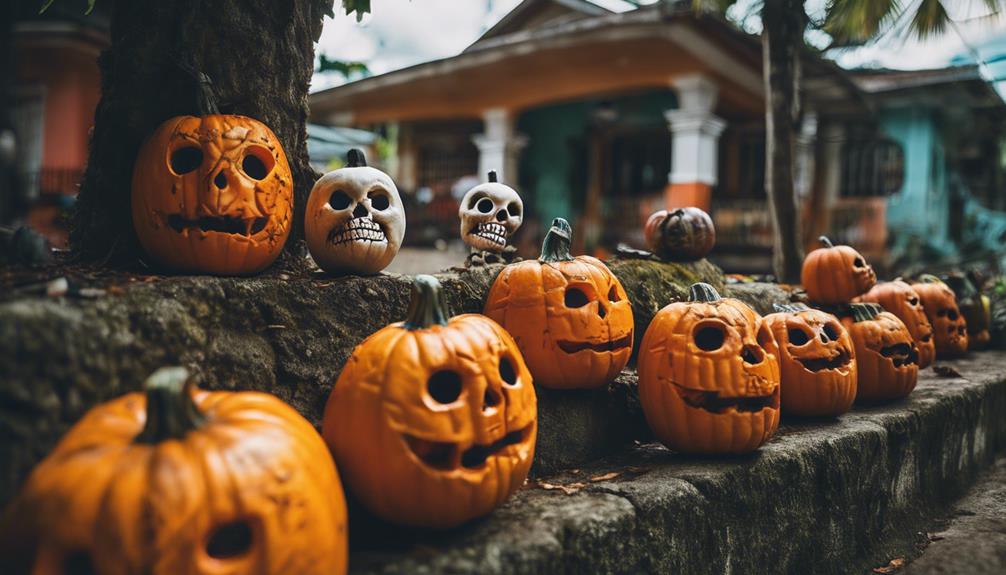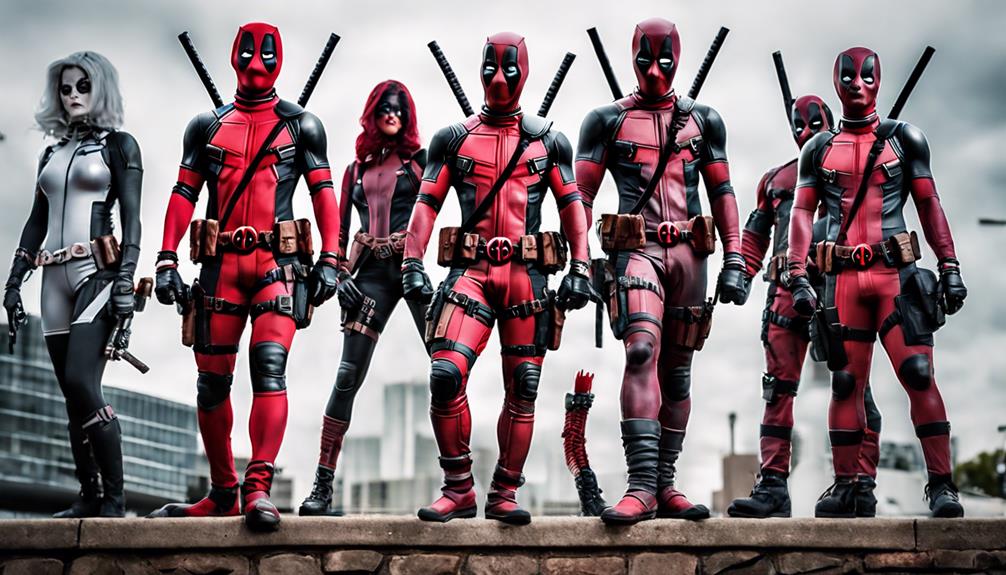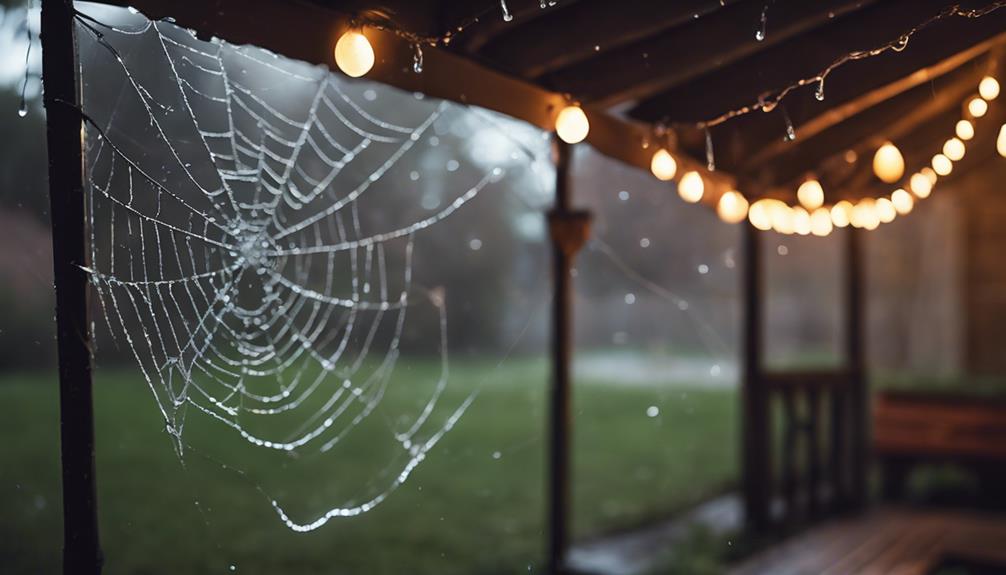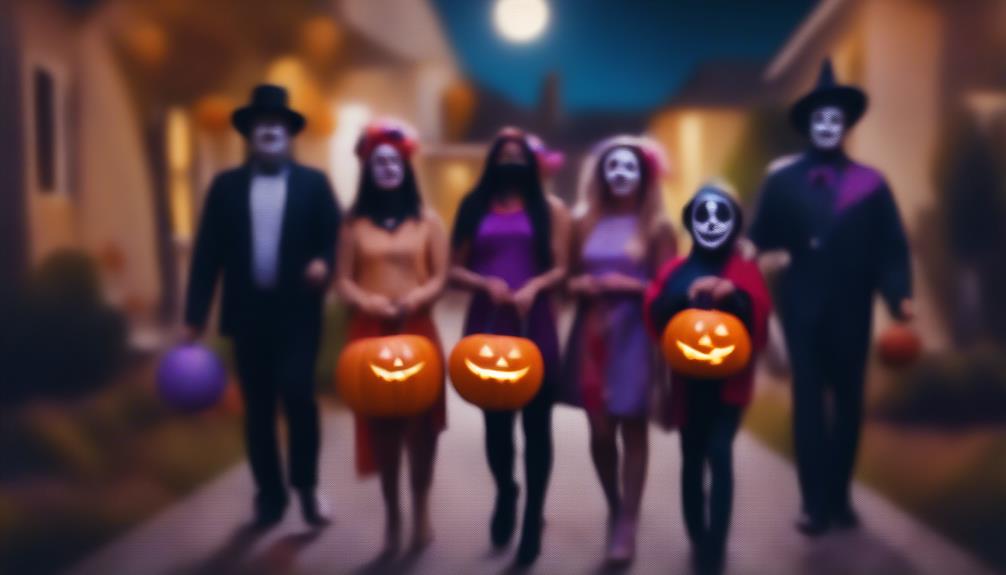Costa Rica uniquely celebrates Halloween as el día de la mascarada on October 31st, showcasing traditional customs. This day honors the country's cultural heritage and indigenous roots through elaborate handmade paper mache masks depicting animals, historical figures, and giant masks from pre-Colombian traditions. Festivities include lively cimarron music bands and colorful parades, blending Catholic influence with indigenous beliefs. These vibrant celebrations reflect Costa Rica's rich heritage, engaging both locals and tourists. Discover more about this fascinating blend of traditions that make Costa Rican Halloween a truly special experience.
Key Takeaways
- Costa Rica celebrates el día de la mascarada on October 31st.
- The celebration honors cultural heritage and indigenous roots.
- It features handmade paper mache masks depicting animals and historical figures.
- The tradition includes giant masks from pre-Colombian customs.
- Cimarron music bands provide lively rhythms during the festivities.
Costa Rican Halloween Traditions
Costa Ricans celebrate el día de la mascarada on October 31st as a vibrant tradition preceding All Saints Day. This celebration in Costa Rica honors the country's cultural heritage and indigenous roots through colorful festivities.
The event features traditional masquerades with participants wearing handmade paper mache masks. These masks often depict animals, mythical creatures, and historical figures, showcasing the rich history of the country. The masquerade parade includes giant masks that trace back to pre-Colombian customs, adding a unique touch to the Halloween celebration.
To enhance the festive atmosphere, cimarron music bands accompany the procession, filling the air with lively rhythms. The significance of these masks lies in their representation of local legends, animals, and historical figures, making the celebration not only visually stunning but also deeply rooted in Costa Rican culture.
Masquerade Day Origins in Costa Rica
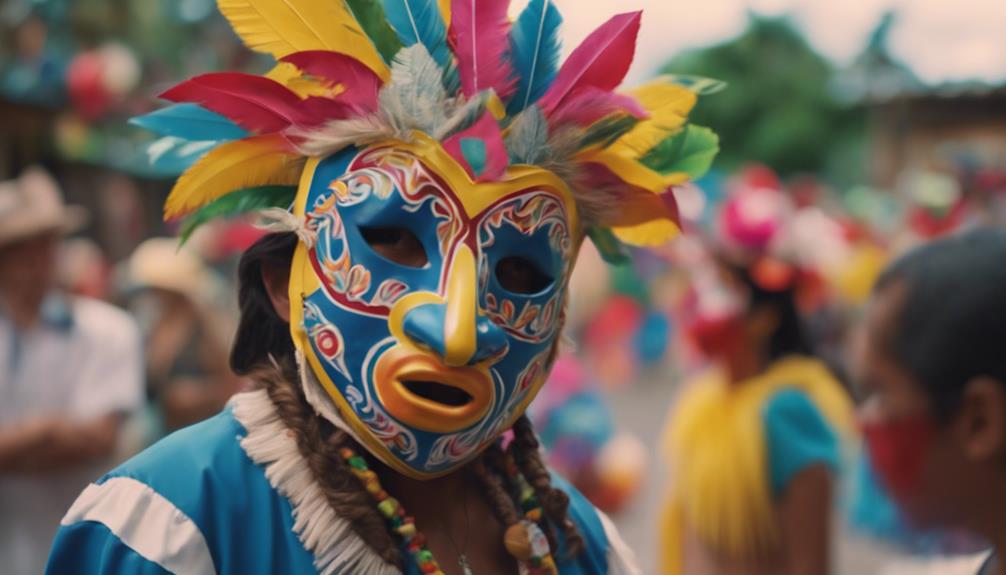
Originating from a tradition introduced during the Spanish colonial period, Masquerade Day in Costa Rica has evolved into a vibrant celebration that combines ancient customs with modern influences.
The first Masquerade Day in Costa Rica dates back to 1824, dedicated to honoring the Patroness of Costa Rica. This celebration intertwines the rich pre-Colombian customs with contemporary elements, creating a unique cultural expression.
In 1996, the tradition of Masquerade Day was officially declared as the National Day of Masquerade in Costa Rica, emphasizing its importance in the country's heritage.
During Masquerade Day, colorful parades featuring giant masks take center stage, showcasing the cultural richness and diversity of Costa Rica. This festive occasion not only highlights the artistic talents of the Costa Rican people but also serves as a reminder of the country's historical roots and the continuous evolution of its traditions.
Masquerade Day stands as a proof to Costa Rica's ability to preserve its heritage while embracing modern influences.
Mythical Masks of Costa Rica
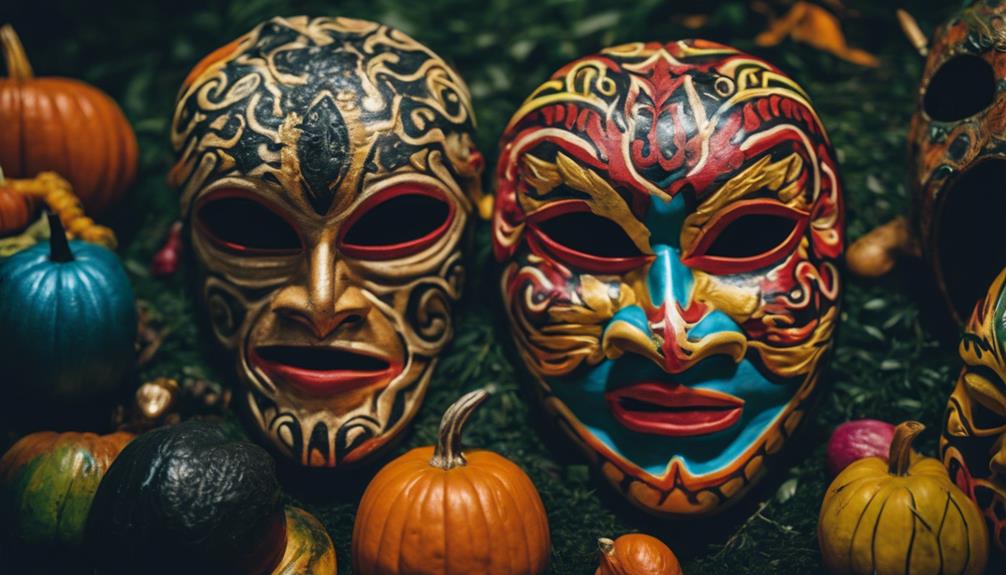
Mythical masks in Costa Rica are intricate, handcrafted creations that depict animals and mythical creatures. Crafted using the paper mache technique, these masks feature vibrant colors and detailed designs.
Symbolizing nature, history, and cultural heritage, these masks are a tribute to Costa Rica's rich traditions and the artistry of its local artisans.
Traditional Mask Designs
Artisans in Costa Rica intricately craft vibrant masks that depict animals, mythical creatures, and historical figures, showcasing the country's rich cultural heritage. These Costa Rican masks are traditional, handmade using the paper mache technique and adorned with vibrant colors. Reflecting the indigenous roots of Costa Rica, these masks hold significant cultural value.
Skilled artisans dedicate themselves to preserving stories and traditions through the intricate designs of these masks. During Masquerade Day, the masks worn celebrate the connection between humans and nature, embodying the essence of Costa Rica's cultural pride. Through these masks, Costa Rica highlights its diverse traditions and continues to honor its heritage with every meticulously crafted piece.
Cultural Significance
In Costa Rica, the cultural significance of mythical masks lies in their intricate designs and vibrant colors that symbolize the country's diverse traditions and rich heritage. These giant, handmade creations, depicting animals and mythical creatures using the paper mache technique, hold symbolic representations of nature, history, and cultural heritage, reflecting the diverse traditions of Costa Rica.
Crafted with intricate designs and vibrant colors, these masks tell stories, preserve culture, and showcase the country's traditional artistry. Mask making is a significant part of Costa Rican culture, highlighting indigenous roots and celebrating shared identity through the art of mask creation.
Cultural Significance of Masks
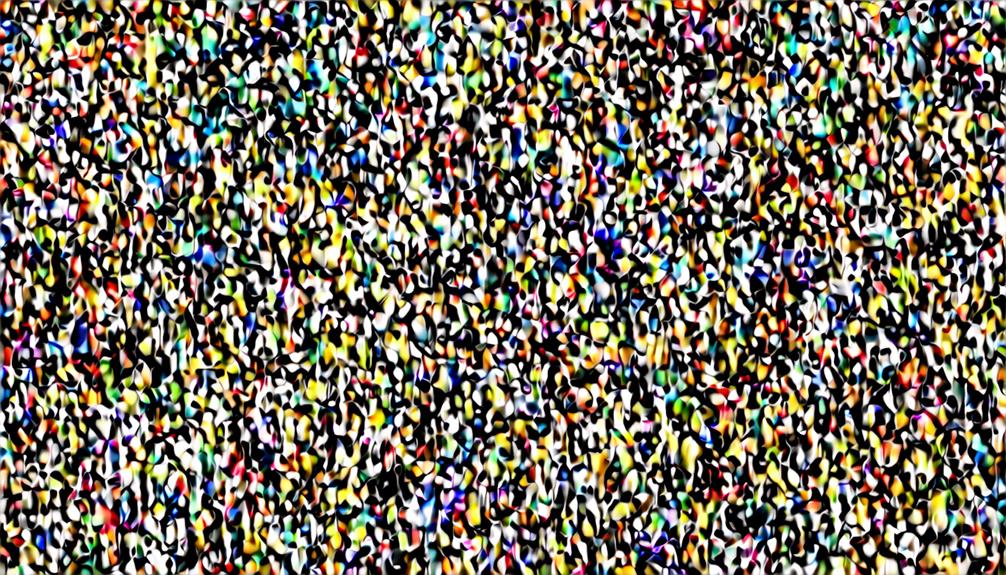
Costa Rican masks hold deep cultural significance, crafted using traditional techniques and adorned with vibrant paints and feathers. These masks symbolize animals, mythical creatures, and historical figures, showcasing the country's diverse traditions and cultural pride.
Through intricate designs and colorful displays, local artisans bring mystery and enchantment to Masquerade Day celebrations, highlighting the connection between humans and nature, folklore, legends, and the rich cultural heritage of Costa Rica.
Traditional Mask-Making Techniques
Traditional mask-making techniques in Costa Rica showcase the intricate artistry and cultural richness through the use of paper mache.
- Artisans in Costa Rica employ handcrafted techniques to create masks that represent a wide array of animals, mythical creatures, and historical figures.
- The process of making these masks reflects the deep-rooted cultural traditions of Costa Rica, highlighting the country's heritage and artistic expression.
- Through their creativity and skill, local artisans infuse each mask with intricate details and vibrant colors, making them truly enchanting pieces of art.
- These masks play a significant role in celebrations, adding an element of mystery and enchantment that mesmerizes both participants and spectators.
Symbolism in Mask Designs
Showcasing a blend of nature, history, and indigenous roots, the symbolism found in Costa Rican mask designs embodies a rich tapestry of cultural significance. These masks symbolize a variety of animals, mythical creatures, and historical figures, reflecting the country's diverse cultural traditions.
Handcrafted with intricate designs and vibrant colors, Costa Rican masks not only showcase artistic expression but also highlight the nation's deep connection to nature and conservation efforts. Local artisans demonstrate exceptional creativity and craftsmanship in the intricate process of mask making, preserving traditional techniques passed down through generations.
Masks worn during Masquerade Day serve as a powerful representation of Costa Rica's cultural identity, emphasizing the importance of conservation and folklore in the country's heritage.
Vibrant Halloween Festivities in Costa Rica
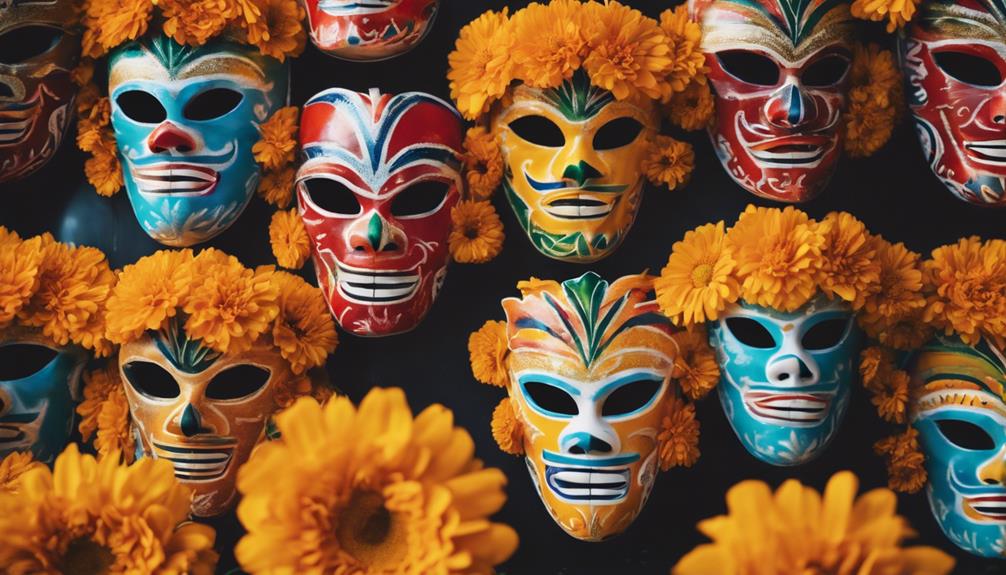
Colorful costumes and giant masks fill the streets of Costa Rica on October 31st during the vibrant Halloween festivities known as el día de la mascarada. This celebration blends pre-Colombian traditions with modern Halloween revelry, showcasing Costa Rica's rich cultural heritage.
Here are some highlights of the vibrant Halloween festivities in Costa Rica:
- Blend of Traditions: El día de la mascarada in Costa Rica reflects a unique fusion of Catholic influence and indigenous beliefs, creating a colorful and dynamic celebration.
- Giant Masks: The streets come alive with giant masks, a symbol of Costa Rican folklore and history, adding a touch of mystique to the vibrant parade.
- Costumed Puppets: Giant costumed puppets representing traditional Costa Rican folk characters march through the streets, captivating spectators with their elaborate designs and storytelling.
- Colorful Parade: The masquerade day parade is a sight to behold, with locals and tourists alike joining in the festivities, adding to the vibrant atmosphere of the celebration.
The Art of Mask Making
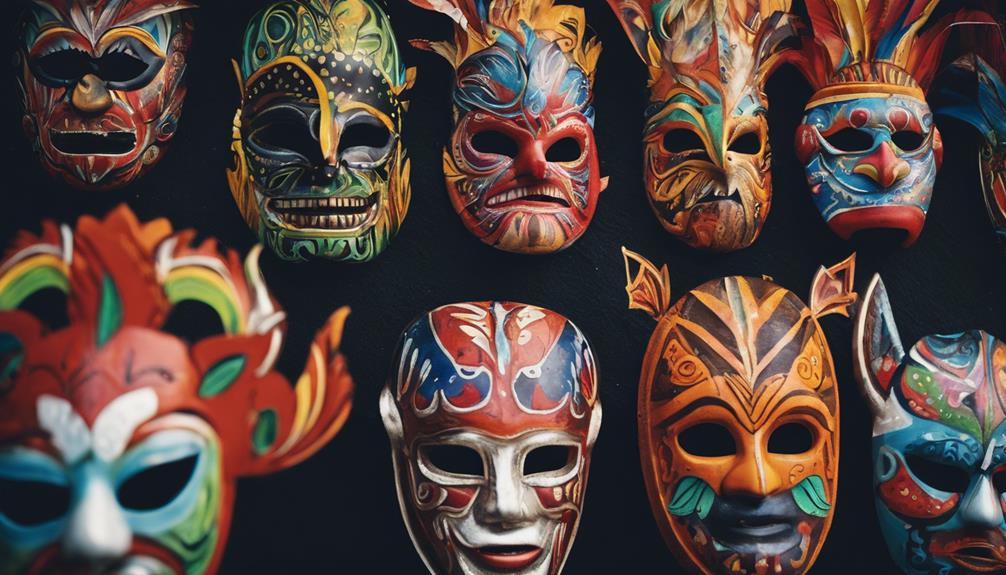
Local artisans in Costa Rica skillfully craft intricate handmade paper mache masks adorned with vibrant colors and feathers, symbolizing animals, mythical creatures, and historical figures. These masks are deeply rooted in Costa Rica's cultural traditions, reflecting the creativity and heritage of the artisans who meticulously create them. The process of mask making is not merely a craft but a form of art that captures the essence of mystery and enchantment, adding a touch of intrigue to Masquerade Day celebrations. The vibrant colors and elaborate designs evoke a sense of wonder, drawing both participants and spectators into the rich tapestry of Costa Rican traditions. Through the art of mask making, artisans pay homage to the country's indigenous roots, preserving ancient techniques and storytelling through their masterful creations.
| Costa Rica Mask Making | |
|---|---|
| Key Aspects | Description |
| Handmade | Artisans craft masks by hand |
| Paper Mache | Masks are made using paper mache technique |
| Vibrant Colors | Masks are adorned with bright and lively hues |
Symbolism in Costa Rican Masks

Symbolic representations embedded in Costa Rican masks reflect the intricate tapestry of the country's cultural heritage and storytelling traditions.
- The handmade Costa Rican masks crafted using the paper mache technique are adorned with vibrant colors that catch the eye and intricate designs that tell stories of the past.
- These masks symbolize various entities such as animals, mythical creatures, and historical figures, offering a glimpse into Costa Rica's rich cultural heritage and indigenous roots.
- Local artisans pour their creativity and expertise into the meticulous process of mask making, showcasing their dedication to preserving traditional art forms.
- The symbolism in these masks goes beyond aesthetics; they serve as a reminder of the deep connection between humans and nature, advocating for conservation efforts and highlighting the cultural significance of wildlife in Costa Rica.
Embracing Costa Rican Heritage

Embracing its rich cultural heritage, Costa Rica celebrates el día de la mascarada on October 31, a tradition deeply rooted in pre-Colombian customs. This vibrant event features a colorful parade where participants don giant masks, harkening back to ancient traditions and reflecting Costa Rica's historical significance.
Cimarron music bands provide lively tunes, adding to the festive atmosphere that permeates the celebration. Handmade masks crafted from paper mache are a focal point of the masquerade, depicting a variety of animals, mythical creatures, and historical figures. These masks not only showcase the country's artistic traditions but also serve as a link to its past, dating back to the pre-Columbian era.
Through el día de la mascarada, Costa Ricans come together in a multigenerational celebration that honors their cultural roots and strengthens the sense of community. This annual event is a demonstration of the enduring traditions that shape Costa Rican identity and unite its people in a shared heritage.
Best Time to Experience Costa Rican Halloween
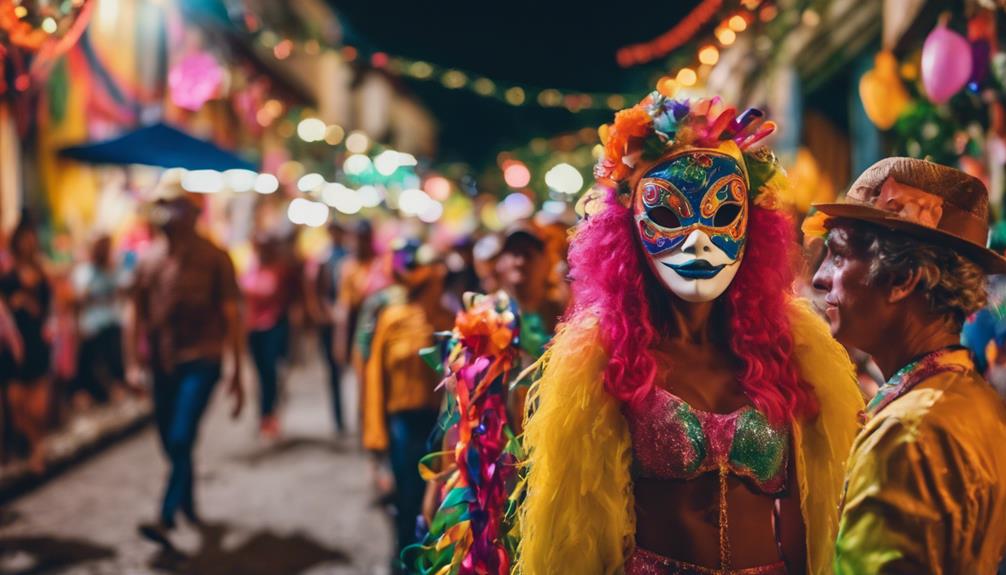
Exploring the vibrant celebrations of Masquerade Day in Costa Rica offers a unique opportunity to immerse oneself in the colorful blend of Halloween excitement and traditional Costa Rican customs. The best time to experience Costa Rican Halloween is on October 31st, during Masquerade Day. Here's why:
- Cultural Twist: Costa Rica puts a unique spin on Halloween with Masquerade Day, showcasing its rich heritage through elaborate masks and traditional dances.
- Giant Masks: Witness colorful parades featuring giant masks that pay homage to animals, mythical creatures, and historical figures, adding a touch of whimsical charm to the festivities.
- Traditional Dances & Music: Enjoy the rhythmic beats and lively tunes that fill the air during Masquerade Day, as locals perform traditional dances that reflect the country's vibrant culture.
- Costa Rican Heritage: Immerse yourself in the essence of Costa Rica by witnessing skilled artisans create intricate masks in cities like Cartago, Escazu, and Barva de Heredia, highlighting the country's artistic talent and cultural pride.
Frequently Asked Questions
How Do They Celebrate Halloween in Costa Rica?
Costa Ricans celebrate Halloween with parades, costume parties, and trick-or-treating for candy. The country infuses spooky legends like CADEJOS and LA SEGUA into its celebrations. Ghost stories, such as La Llorona, and haunted locations like Cartago enhance the mysterious atmosphere.
Supernatural beings like duendes are believed to inhabit rainforests in Arenal and Monteverde during Halloween. This unique blend of Catholic and indigenous influences creates a distinctive cultural fusion during the holiday.
What Does Costa Rica Celebrate in October?
In October, Costa Rica celebrates 'El día de la mascarada,' a vibrant tradition featuring a lively parade with oversized masks. This event, rooted in pre-Colombian customs, showcases cimarron music bands and pays homage to Costa Rican cultural heritage.
Handcrafted paper mache masks in vivid hues depict animals, mythical beings, and historical figures. The government officially recognized October 31 as the Day of Traditional Costa Rican Masquerade in 1996, making it a cherished multigenerational family affair.
What Holiday Do Costa Ricans Celebrate?
Costa Ricans celebrate el día de la mascarada, a traditional holiday on October 31st. The celebration precedes All Saints Day, showcasing culture and heritage with a colorful parade featuring giant masks from pre-Colombian customs.
Accompanied by cimarron music bands, this event is a multigenerational family affair. Masquerade Day in Costa Rica promotes cultural knowledge and identity, dating back to the pre-Columbian era.
Does Costa Rica Have Any Traditions?
Costa Rica has rich cultural traditions.
One popular celebration is el día de la mascarada, which takes place on October 31st. The event features a vibrant parade with giant masks, rooted in pre-Colombian customs.
Families gather to enjoy the festivities, accompanied by cimarron music bands. These bands, comprised of self-taught musicians, play traditional tunes, promoting cultural knowledge and celebrating the country's heritage.
Costa Rica's traditions are diverse and deeply meaningful to its people.
Conclusion
To sum up, Costa Rica's unique Halloween traditions, such as Masquerade Day and the art of mask making, offer a vibrant celebration of culture and heritage.
The colorful masks and festivities symbolize the rich history and folklore of the country, creating a mesmerizing experience for locals and visitors alike.
Embracing Costa Rican Halloween is a chance to immerse oneself in a world of mythical stories and artistic expression, making it a truly unforgettable experience.
